Content
- 1 Varieties and varieties of garden chrysanthemums with photos
- 2 Garden chrysanthemums - planting and care
- 3 Diseases and pests of perennial chrysanthemums
- 4 Reproduction of bush chrysanthemum
- 5 Planting chrysanthemums
- 6 Reproduction of chrysanthemums
- 7 Chrysanthemum care
- 8 Types and varieties of chrysanthemums
- 9 Growing chrysanthemums from seeds
- 10 Planting chrysanthemums with cuttings
- 11 Reproduction by dividing the bush
- 12 Planting and caring for spray chrysanthemums
 From mid-summer until the very frost, many homesteads, summer cottages and front gardens are decorated with bright bushes of garden chrysanthemums. The plant blooms even when many flowers have already withered after the first frost. Even the most experienced gardeners are amazed at the variety of flower colors, types and shapes. You can learn about the varieties and characteristics of growing the "Queen of Autumn" by reading our article. And photos of chrysanthemums will help you choose the types of flowers suitable for the garden.
From mid-summer until the very frost, many homesteads, summer cottages and front gardens are decorated with bright bushes of garden chrysanthemums. The plant blooms even when many flowers have already withered after the first frost. Even the most experienced gardeners are amazed at the variety of flower colors, types and shapes. You can learn about the varieties and characteristics of growing the "Queen of Autumn" by reading our article. And photos of chrysanthemums will help you choose the types of flowers suitable for the garden.
Varieties and varieties of garden chrysanthemums with photos
Garden chrysanthemum is a perennial plant whose height depends on the species and can be from 15 to 150 cm... Currently, a large number of varieties of chrysanthemums are known, which, according to some features and characteristics, are combined into groups.
The size of the inflorescences
Perennial chrysanthemums are divided into three groups according to the diameter of the flowers:
- small-flowered;
- mid-flowered;
- large-flowered.
Small-flowered or Korean plants can be simple and double. A large number of inflorescences grow on one bush with a flower diameter of 2-10 cm... The bushes themselves can reach a height of 25 to 120 cm. The leaves of the plant are in the form of oak leaves. Flowers are frost-resistant, undemanding to the composition of the soil and easy to care for. Their flowering begins in mid-September and continues until the very frost.
Mid-flowered or ornamental chrysanthemums can be grown not only for garden decoration, but also for cutting. They also grow well in pots at home. They can be used to decorate balconies, loggias and terraces. Ornamental shrubs grow up to 30-70 cm, and have a flower diameter of 10-18 cm.
Large-flowered chrysanthemums are spectacular tall plants. The length of their stem can reach from 80 to 120 cm. They bloom in large flowers with a diameter of 10-25 cm. This type of chrysanthemum does not tolerate frost well. Only some of its varieties can winter outdoors. Such flowers are intended mainly for cutting into bouquets.
The shape and height of the bush
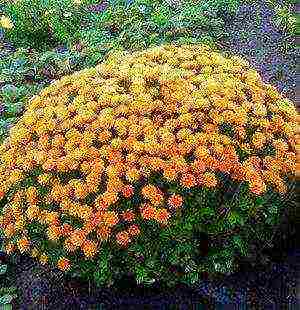 According to the shape and height of the bush, garden chrysanthemums are divided into three types, each of which has many varieties.
According to the shape and height of the bush, garden chrysanthemums are divided into three types, each of which has many varieties.
Tall. The stems of this type of garden chrysanthemum can be very tall and require supports such as frames, metal nets, or wooden pegs. Supports are installed during the planting of the bushes. Plants planted in a group can be used as a hedge. Most popular varieties tall garden chrysanthemums are:
- "Amber Lady" - the plant is distinguished by golden inflorescences.
- "Umka" - chrysanthemums with white flowers, the shape of which resembles a pompom.
- "Daughter of Rosetta" is strewn with flat inflorescences with flowers of pink and white shades.
Medium-sized. Bushes growing up to 30-50 cm look very impressive both on a flower bed and along paths, fences, arbors.With their help, you can realize various design fantasies. The best varieties of medium-sized garden chrysanthemums are considered:
- "Dawn" - the plant has a yellow-brown color, which is just right for the autumn mood.
- "Dune" is a truly magical variety, the flowers of which can change their color during flowering. They bloom yellow-brown, and after a few days they turn yellow-gold.
- "Lily" will help to add brightness to any composition with its dark crimson flowers.
Curb. Small plants grow up to only 30 cm. This type of chrysanthemum is considered one of the most beautiful garden flowers. Bushes of curb chrysanthemums have the shape of a ballcovered with small flowers. In this group, the most popular varieties:
- "Barbara" is a plant with delicate lilac-purple flowers.
- "Evening Lights" - the variety is distinguished by scarlet inflorescences that resemble a festive fireworks.
- "Talisman" is strewn with bright beetroot-crimson flowers.
Flower shape
Garden chrysanthemums have five different kinds of flower shapes:
-
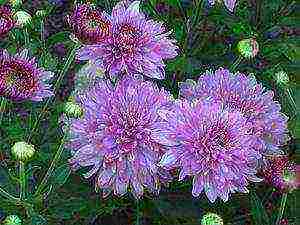 Pompom flowers are an assembly of tongues that are assembled into a ball that resembles a pompom.
Pompom flowers are an assembly of tongues that are assembled into a ball that resembles a pompom. - Anemoid flowers consist of large petals, which are collected in one, two or three rows. The flowers themselves are small in size and very similar to anemone flowers.
- Single-row and double-row inflorescences are bordered by flowers that look like tongues. In the center of such inflorescences, small tubular flowers grow. The border of flowers can be arranged in one or two rows.
- Semi-double flowers consist of three rows of reeds that are arranged around a central flower.
- Terry inflorescences are similar to semi-double ones, but their flowers are more luxuriant, since they are diverse in appearance and shape.
Garden chrysanthemums - planting and care
It is recommended to plant a plant during the period from late May to mid-June... Until autumn, the bushes will have time to take root and get stronger. And then they will not be afraid of any winter frosts.
Landing features
Chrysanthemums love sunny areas. The plant requires a lot of light to set flower buds. Even in partial shade, chrysanthemums will not bloom.
The soil must be rich in organic matter. Therefore, during digging, one bucket of manure, compost or peat must be added to one square meter of soil. You don't need to add more organic matter, otherwise only leaves will grow rapidly on the bush, and the plant will bloom with very small flowers.
When planting a garden chrysanthemum, it is recommended:
-
 For large bushes, the distance between the holes must be at least 50 cm, and for small bushes - 25 cm.
For large bushes, the distance between the holes must be at least 50 cm, and for small bushes - 25 cm. - It is recommended to add drainage or sand to each hole.
- When planting, the plant cannot be deepened deeply into the ground.
- Near large, tall bushes, you must immediately install a support.
- The leaves of the plant can be sprayed with Epin to help it adapt better. "Kornevin" is also suitable, with a solution of which the bush is watered.
- If frosts are still expected, then the young bush should be covered with non-woven material at night.
Care rules
When caring for a garden chrysanthemum, special attention should be paid to watering it, since the plant depends on soil moisture level... You need to water the bushes in a timely manner, otherwise the flower will throw off all the buds.
The amount of water for watering one bush depends on its characteristics. Plants with small, stiff leaves can be watered less frequently than plants with soft, large leaves that evaporate a lot of moisture.
Chrysanthemums respond well to feeding. For this, complex mineral fertilizers containing magnesium and potassium, and organic in the form of humates are used. During the active growth of green mass, the plant is fed with nitrogen.
Caring for garden chrysanthemums involves forming a bush. It is necessary regularly pinch and trim... For the first time, the top of the plant is removed when the central shoot grows to 10 cm.After a while, when lateral shoots grow up to 10 cm, the crown of their head is also pinched. After that, the bush grows to bloom.
During the period when the chrysanthemum blooms, faded and wilted buds should be regularly removed from its bush. This way the flowering period can be extended.
If you want to get big beautiful flowers, you can make a total pruning of side shoots. As a result, only one stalk and one peduncle will remain on the bush. All the forces of the plant will go to the formation and growth of the flower.
Winter garden chrysanthemum care
 In order for a plant planted in the garden to bloom as beautifully and profusely next year, you need to make sure that it overwinters well.
In order for a plant planted in the garden to bloom as beautifully and profusely next year, you need to make sure that it overwinters well.
In frosty winters even cold-resistant varieties require shelter... Therefore, after the end of flowering, the stems of the bushes are cut to the ground. The plant hides and covers itself with fallen leaves.
Chrysanthemums with large flowers are afraid of freezing temperatures. Therefore, they need to be dug out together with an earthen lump and planted in a suitable container. Plants are stored before planting in the spring in a room with a temperature of 0-5 degrees. Caring for them consists in rarely watering an earthen coma, which should not dry out.
Diseases and pests of perennial chrysanthemums
With proper care, the plant is rarely affected by pests and practically does not get sick. However, the bushes need to be inspected regularly in order to identify the problem as soon as possible and begin to treat the plant. The threat to garden chrysanthemums is posed by:
- Spider mite is a pest that sucks juice from a plant. It can be found by the cobweb formations on the back of the sheet. If the leaves of a chrysanthemum become gray-brown, begin to darken and fall off, then, most likely, a tick has settled on it. The plant must be treated with special chemicals.
- Leaf nematodes - the disease is manifested by deformation of the leaves, and their darkening between the veins. In this case, you need to change the soil and cut off the damaged areas.
- Verticillosis is an infectious disease that spreads through the roots. Therefore, the leaves begin to turn yellow and wither from the bottom of the bush. In the initial stages, spraying with biological products will help.
- Powdery mildew first affects the leaves and buds, on which a white bloom appears. The affected parts of the plant are removed, and the bush itself is treated with Bordeaux liquid.
Reproduction of bush chrysanthemum
Chrysanthemum can propagate in three ways:
- dividing the bush;
- seeds;
- by cuttings.
Dividing the bush
The bushes can be divided in the spring, but only after the threat of frost has passed. In order for chrysanthemums to bloom better, it is recommended to divide their bushes every three years. To do this, the plant is carefully dug up and divided into several small bushes. The roots of the plant will need to be cut. Delenki are planted in the ground and watered.
Seed reproduction
In open ground sowing is done in May... For each future plant, a separate hole is dug, the distance between which should be 25 cm. 3-4 seeds are buried in one hole. For the first time, chrysanthemums should bloom at the end of summer.
Cuttings
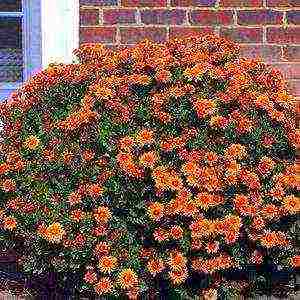 Propagation by cuttings is the easiest way, since chrysanthemums take root quickly and well.
Propagation by cuttings is the easiest way, since chrysanthemums take root quickly and well.
- A stalk with 3-4 leaves is cut under a leaf pattern. Its length should be 6-8 cm.
- The container is filled first with peat, and then with sand, into which the stalk sits.
- The soil is sprayed and the box is covered with glass.
The rooting temperature should be between 13-15 degrees. When the roots appear, the cuttings will need transplant into separate pots... Young bushes are planted in open ground only when frost has passed.
Observing the rules of planting and caring for garden chrysanthemums, you can achieve a beautiful and spectacular flowering during half summer and almost all autumn. Any part of the garden where the "Queen of Autumn" will grow will become a luxurious decoration of the garden.
Bush chrysanthemum
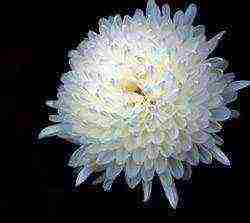 Among the huge variety of luxurious flowers, the perennial chrysanthemum occupies a special place. "Queen of Autumn" - this is how sophisticated breeders and lovers of bright colors and magnificent forms speak of her. Today we will talk about what varieties and varieties of perennial chrysanthemums are found, how best to care for these colorful pets. Photos of magnificent chrysanthemums will help you enjoy the riot of colors and choose varieties.
Among the huge variety of luxurious flowers, the perennial chrysanthemum occupies a special place. "Queen of Autumn" - this is how sophisticated breeders and lovers of bright colors and magnificent forms speak of her. Today we will talk about what varieties and varieties of perennial chrysanthemums are found, how best to care for these colorful pets. Photos of magnificent chrysanthemums will help you enjoy the riot of colors and choose varieties.
Chrysanthemums: varieties and varieties
It is not in vain that they say about perennial chrysanthemums that they inspire optimism in a convinced pessimist. After all, these lush and fragrant flowering plants can make bright not only a personal plot, but also the life of a gardener who grows picturesque plants and horticultural crops.

Chrysanthemums can be completely unusual and bright colors.
Every time you buy a bag of an unknown variety, you are amazed at the duration of its flowering, magnificent colors, plant height, shape and texture of the petals, as well as the degree of their doubleness.
Breeders divide chrysanthemums into:
- simple forms;
- large-flowered;
- terry.
There is also a gradation in color, flowering periods, flower size and decorativeness. Many subspecies of chrysanthemums are intended only for subsequent cutting and making bouquets - these are the so-called bouquet chrysanthemums. Their height can vary from 15 to 150 cm. Such a wide range allows you to decorate entire flower gardens with a variety of cultures, which will bloom and delight the eye at different times - from mid-June to the first snow.

Chrysanthemum flowers of various shapes and sizes
As for the color of the buds, it is impossible to immediately list all the colors and shades. There is an unthinkable number of colors that excite the imagination: white and lemon, orange and purple, crimson red, lilac and emerald.
The historical homeland of chrysanthemums is Northern China, where residents were actively engaged in breeding this amazing and, fortunately, unpretentious garden culture. Thanks to the merits of professional breeders, today it is possible to grow chic varieties of perennial chrysanthemum with excellent consumer properties.
The most widespread and well-known variety - "Early Yellow" is close in decorativeness to Japanese anemones. Today there are about 700 varieties of these garden plants.
- Very popular bush chrysanthemums, which are equally suitable for arranging the landscape of the garden, and for cutting.
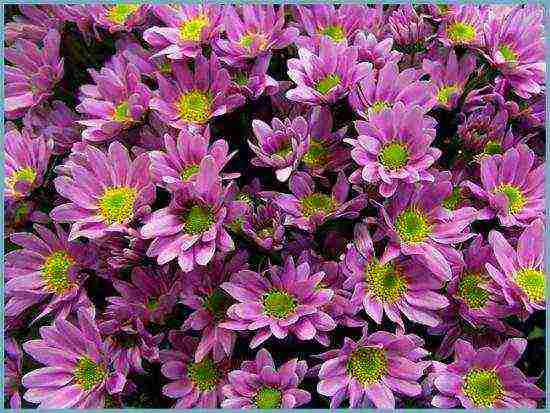
Bush chrysanthemums
- Also meet feathery double flowers with a very dense and lush planting of petals. Due to this, they take the shape of a ball, completely covering the flower bed.
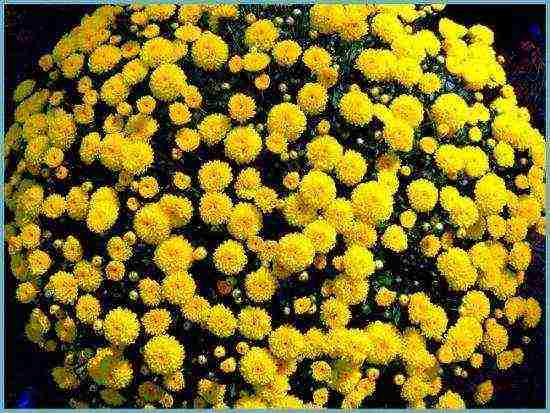
Terry chrysanthemums
- Bristly chrysanthemums attract attention with their thin and slightly twisted petals, which outwardly resemble graceful brushes.
- Pompon varieties chrysanthemums boast an ideal spherical shape. Dense terry, bright colors and long flowering in any growing conditions are the undoubted advantages of this variety.
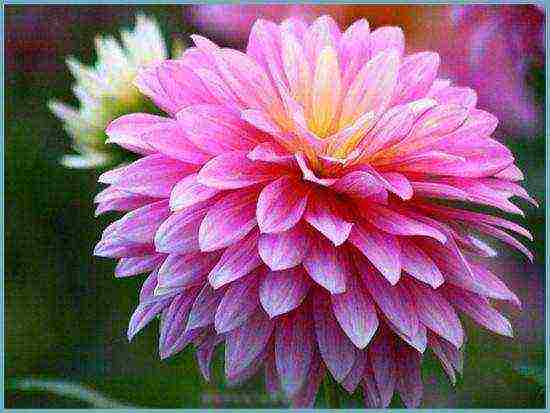
Pompom chrysanthemums
- Semi-double varieties include a great variety of shapes, colors and structures. A prominent representative of this group is a garden plant with slightly drooping inflorescences. Their middle is almost not closed, and along the edges there are petals of the most unexpected shades and shapes.
- Simple varieties are represented by very graceful and at the same time uncomplicated inflorescences, outwardly resembling a garden chamomile in shape.
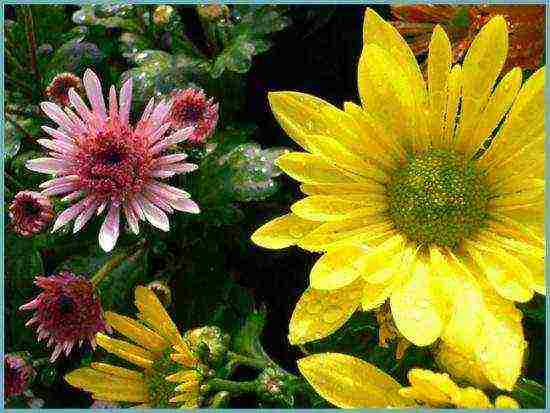
Simple varieties
- Perennial chrysanthemums anemone-like varieties easy to recognize by the simple shape and slightly convex heart of the inflorescence. It seems to rise above the petals and reach for the sun. These are the most delicate representatives of garden chrysanthemums, which smell pleasantly and create a good impression.
- Spoon-shaped chrysanthemums belong to rare varieties. Already by the name it can be understood that the flowers are somehow magically connected with spoons.The thing is that the shape of each petal resembles a teaspoon.
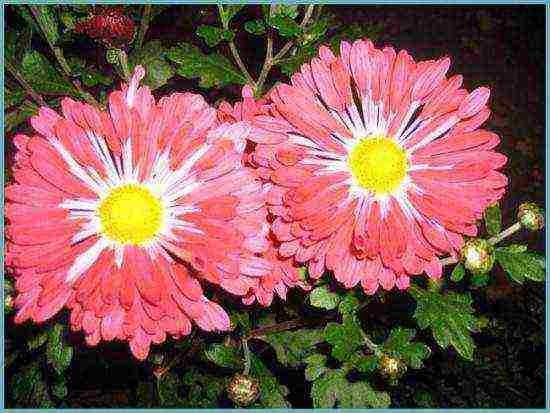
Spoon-shaped chrysanthemums
Chrysanthemums: planting and care in the open field
Perennial chrysanthemums do not like darkening and high humidity very much, so it is better to plant them in a small hill and in a sunny place. This will save you from pulling shoots, changing the time and duration of flowering.
Attention! Chrysanthemums have a superficial root system, so overdrying the soil is unacceptable!
For planting, it is recommended to use very loose and moisture-permeable soil with sufficient nutrient content. If the soil is too dense, it is recommended to mix it with peat or compost. To improve drainage qualities, you can use coarse sand and fine gravel.
Attention! Garden chrysanthemums, which are not labor intensive to grow, prefer a neutral potting mix.
A cloudy, or even better rainy day is chosen for planting. A hole up to 40 cm deep is watered abundantly, drainage is done. Then a chrysanthemum is placed and lightly sprinkled with earth.
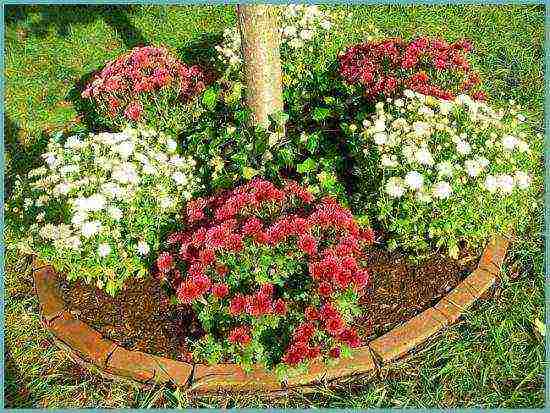
Chrysanthemum thrives in the shade of trees
Attention! The plant should not be deeply buried, because the root system grows parallel to the ground.
If low-growing varieties will be grown, then you need to worry about additional support in advance.
A couple of days after planting, you can remove the growth point on the culture. After another 3 weeks, the tip of the shoot is neatly broken off.
Advice! After planting the plant in the ground, shade it using a non-woven material. Make sure that it does not touch the leaves of the plant.
Plant care
When growing garden chrysanthemums on a garden plot, it is important to remember that watering should be moderate, otherwise the plant will rot from an excess of moisture. An exception, perhaps, can only be a very dry and hot period.
Attention! Lack of moisture can lead to woody plant stems and loss of decorative effect.
Further care of your perennial garden culture will not take much of your time. Regular watering, thorough loosening, timely feeding and spraying from various parasites are all the activities that will be required for the full growth and colorful flowering of the chrysanthemum.
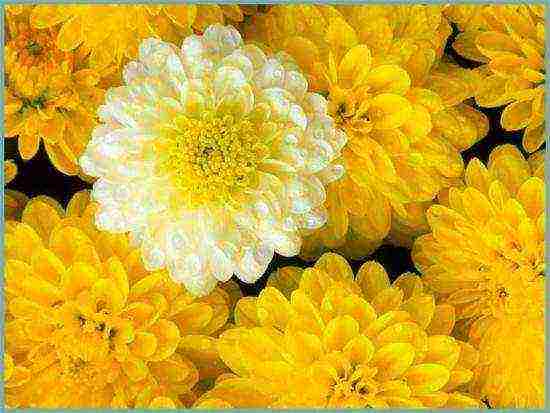
The moisture balance in the soil is very important for the crop.
You need to take special care of the culture closer to cold weather and frost (end of October). Despite the fact that chrysanthemums tolerate low temperatures well, it is better to build them a frame with a film coating. Such a simple measure will allow you to admire the bright colors and lush flowering of delicate flowers for another month. The frame can be removed by December, and the bushes can be planted in pots and placed on the windowsill in a bright veranda, where the chrysanthemum will bloom until January.
Fertilizing and feeding chrysanthemums
The plant is fed weekly with mullein infusion in a ratio of 1: 10. Lush blooms can be obtained by introducing a balanced amount of phosphorus and potassium fertilizers into the soil, and the green mass can be increased using fertilizing based on nitrogen.
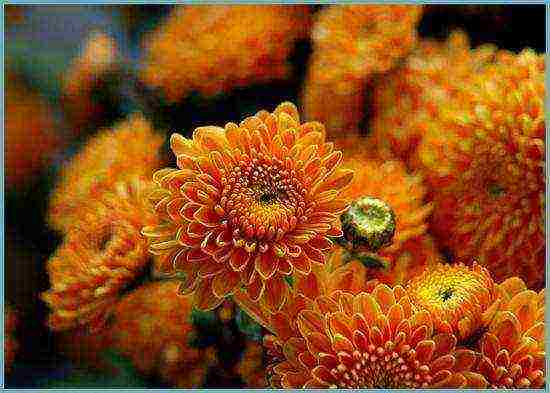
The more often you feed the chrysanthemum, the more lush and longer it will bloom.
Attention! At the time of fertilization, it is important to ensure that the fertilizing does not fall on the leaves and cause them to burn! It is better to under-feed the plant than to burn it!
Plant propagation
Breeders recommend propagating a perennial crop only by cuttings and dividing the bush, since the seeds often do not preserve the variety.
Attention! Reproduction is best done in late spring (in May), when the probability of frost is minimal. The beginning of summer is also a good period for replanting the plant.
If you have material for planting only closer to autumn, then have time to plant it by mid-September so that the first frosts do not break the spirit of the plant.Otherwise, the seedling can be transplanted into a wide, but (very important!) Shallow pot, having previously cut it low.
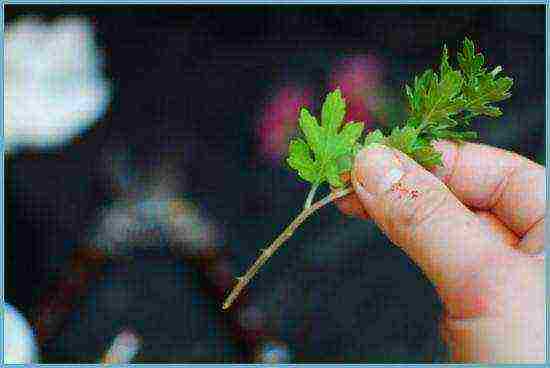
Chrysanthemum reproduces well by cuttings
The container with the planted chrysanthemums is placed in a dark place (it can be a loggia or a terrace), where the temperature is kept at a constant level of 4-6 ° C. Throughout the winter period, it is necessary to maintain an optimal level of soil moisture.
At the end of winter, bushes can be planted in a greenhouse or flower greenhouse, where they should be watered as often as possible. By the end of March, when the shoots have grown a little, you can cut the cuttings and carefully plant them in a box with a mixture of soil, humus and sand, then cover them tightly with a sheet of glass. A month later, when the cuttings take root, they can be planted in wider containers, and then in open ground.
Diseases and pests
Since a great many different microorganisms live in any soil, the plant periodically needs to be treated with special preparations that will reliably protect against diseases and pests, root rot. Abundant watering will keep the crop from mites and aphids that cannot tolerate moisture. The bush chrysanthemum Ratibor, Aktara, Fitovermi and other preparations will save from snails, leaf rollers and caterpillars.
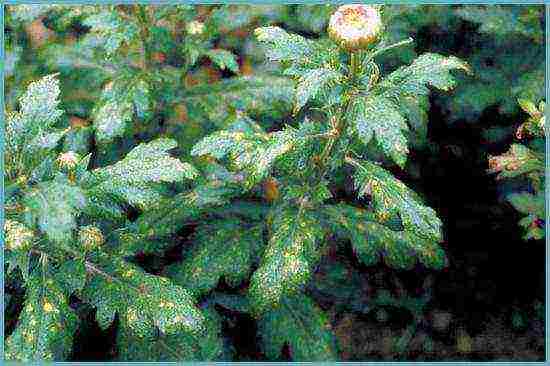
White rust
Shrub chrysanthemum: combination with other plants
Perennial garden culture goes well with fruit trees (it can be rowan or wild apple). A good combination is given by raspberries growing nearby, sea buckthorn, barberry. Shrub chrysanthemum looks incredibly attractive in the company of decorative leafy plants - hydrangea, ivy, wild grapes, lemongrass.
The chrysanthemum looks charming and gentle surrounded by tall perennial plants: dahlia, shrub aster, asparagus and other plants.
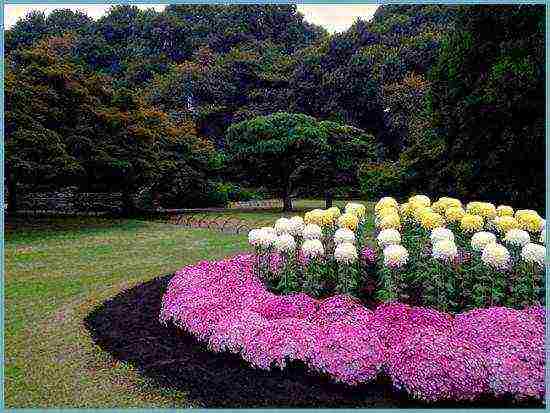
Chrysanthemums in landscape design
Shrub chrysanthemums in landscape design
Lush and bright chrysanthemums are the perfect decoration for any garden and site. With the participation of these plants, you can get luxurious flower beds and mixborders, with the help of them glades and lawns are decorated. Among the bright emerald greenery, shrub chrysanthemum makes up expressive spots of orange, purple, lilac color. Almost all varieties of shrub chrysanthemum are suitable for a spectacular landscape design.
How to grow a chrysanthemum: video
Types of chrysanthemums: photo
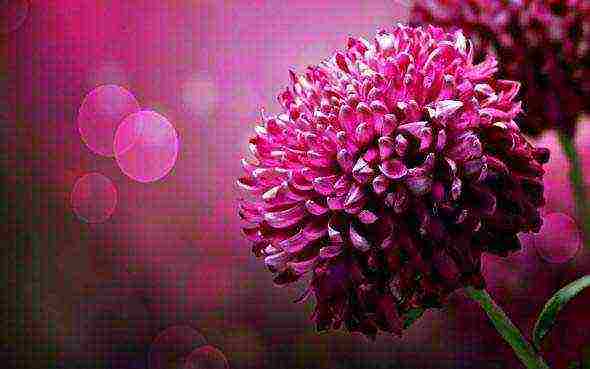
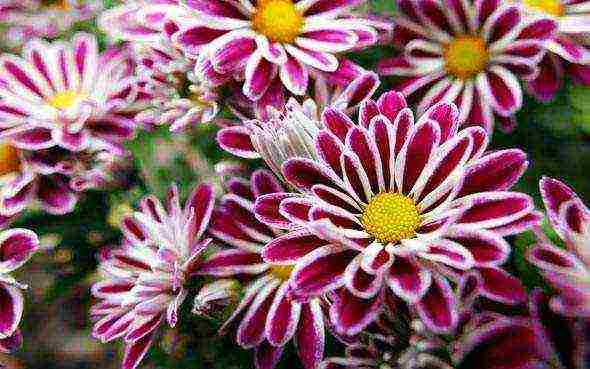
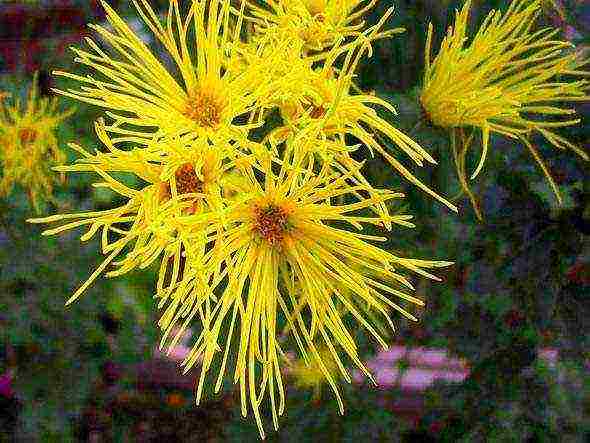

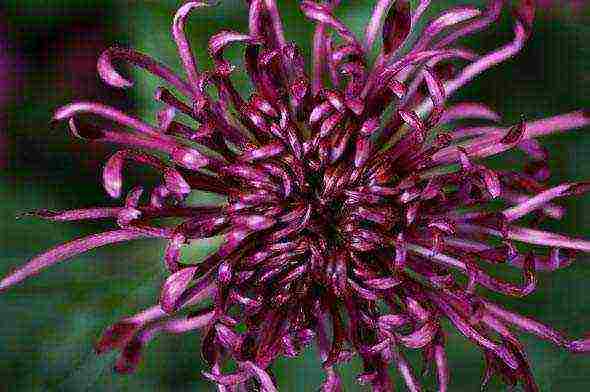
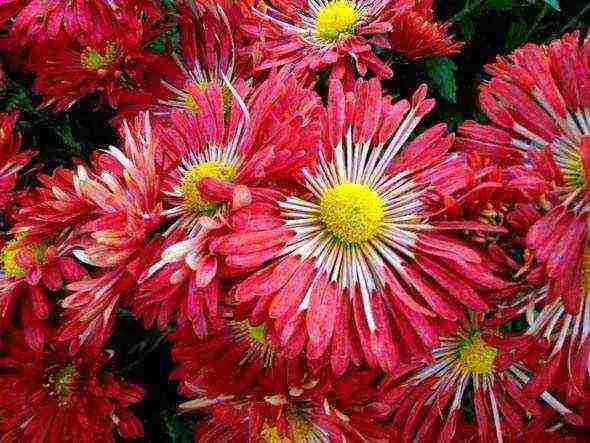
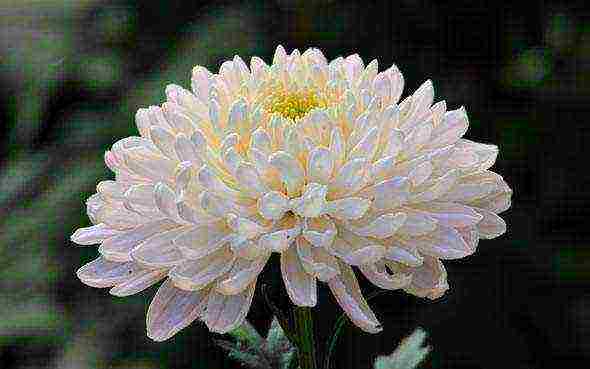


Eastern wisdom advises everyone who wants to live a happy life to grow
chrysanthemums
... According to an ancient Chinese legend, the white dragon tried to encroach on the sun itself. He tore it with teeth and claws, and sparks fell to the ground and turned into yellow flowers, which were later called chrysanthemums. They are depicted on the Japanese coat of arms, coins and seals, which does not bother Asians
cook with chrysanthemums
cakes and salads. As a garden flower, chrysanthemum has been known for three millennia, but interest in it is only growing.
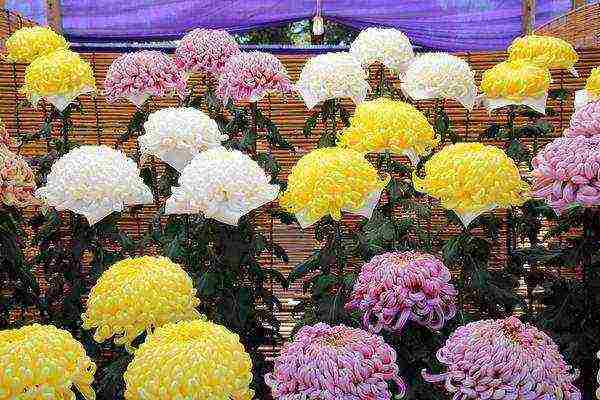
Breeders are constantly striving to get as large-flowered varieties as possible, but gardeners are more attracted by small-flowered Korean chrysanthemums, since they are resistant to low temperatures, are good outdoors in combination with other flowers, have high decorative qualities, bloom for a long time and profusely almost until November ... Therefore, it is not for nothing that chrysanthemum is considered the queen of autumn. In addition, it is grown in pots to decorate houses, and in cut form, it lasts for a long time - up to 30 days, so it is ideal for bouquets.

In the open field, chrysanthemum blooms in August and pleases with its lush flowers all autumn, withstands frosts down to -7 ° C. Depending on the variety, the stems reach a height of 30-80 cm and are decorated with double, semi-double and simple inflorescences of unusually diverse shades.
In the northern regions of Russia, it is believed that it is impossible to grow chrysanthemums outdoors, but in fact, they can successfully winter with light
hideouts
in central Russia and even in Siberia! In these areas, after cutting the stems, hemp 10-15 cm high is well spud
peat
, cover with foliage and insulate
spruce branches
.
Planting chrysanthemums
Chrysanthemums do not like the slightest shading and moisture retention, so the place for them should be sunny and at least slightly elevated. This is a guarantee that the shoots will not stretch, change the time and period of flowering. However, the root system of chrysanthemums is superficial, so the soil should not be overdried either.
The ideal soil for them is loose, moisture-permeable, with an optimal amount of various nutrients. With dense and infertile soil in the garden, before planting the cuttings, a little peat, compost or rotted manure is introduced into the soil, but do not abuse them, otherwise the plants will be too tall to the detriment of flowering. Add a small amount of coarse sand to the soil for drainage. The soil mixture is preferably neutral or slightly acidic.
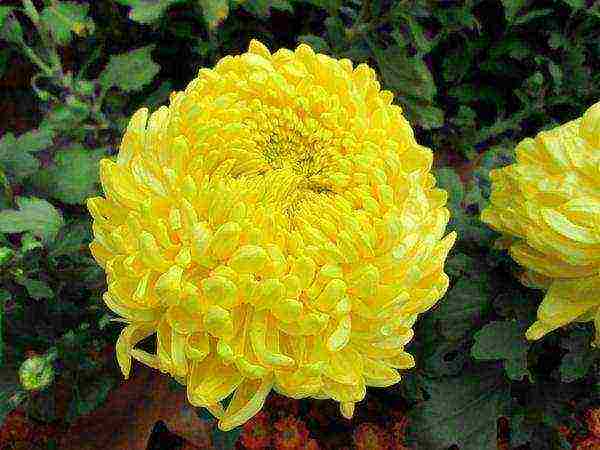
The ideal day for planting is cloudy or rainy. In hot, sunny weather, plant cuttings in the early morning or late evening when the sun is less active. Pour holes 35-40 cm deep with plenty of water, put drainage, earth mixed with vermicompost in a ratio of 20: 1. Chrysanthemum is placed and covered with earth. The roots grow parallel to the soil, so they are not buried too deep. For tall varieties, additional support is needed.
Immediately after planting in the ground, the first pinching is carried out - the growth point on the plant is removed. 3 weeks after planting, break out the upper part of the shoot with 2-3 nodes - the second pinch. The first days after planting, artificially shade the seedlings so that they do not suffer from bright sunlight. The best option is a non-woven fabric, but it is advisable that it does not come into contact with the leaves.
Reproduction of chrysanthemums
Since varietal characteristics are not preserved when propagated by seeds, chrysanthemums are propagated
cuttings
, dividing the bushes or root shoots, which are separated from the mother bush.
In any case, it is necessary to plant and transplant chrysanthemums. in the spring, in May, when frosts and cold snaps pass. It is also acceptable at the beginning of summer - this will not affect the development of chrysanthemums.
In the next video, you can see the breeding process of chrysanthemums by dividing the bush in the spring.
If you got hold of the planting material closer to autumn, then plant it in the ground
until September 15 , so that before the onset of frost, the plants have time to take root well. If you did not have time during this period, then plant the seedling in a shallow wide pot, cutting low. Send the container with chrysanthemum to a dark place to a warm loggia or a heated terrace, where until spring the temperature will be at the level of 4-6 ° C - these are the optimal conditions for the successful development of plants. Moisten the ground periodically throughout the winter.
From the end of February, chrysanthemums are planted in a greenhouse and watered more often. By the end of March, the shoots will grow back, and it will be possible to engage in cuttings - cut off the shoots no more than 10 cm.
Carefully plant the cuttings in a box filled with a mixture of earth, sand and humus in a 1: 2: 1 ratio, close tightly with glass. After a month, the cuttings will take root, they can be planted in wide containers. As soon as the danger of an unexpected cold snap has passed, it will be possible to transplant the mother plant and seedlings into the ground.
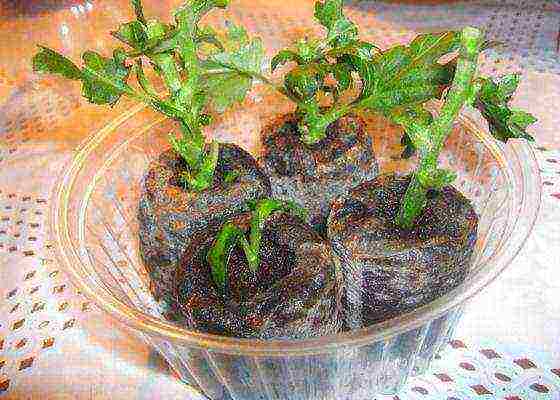
Chrysanthemum care
The watering regime should be moderate, in which the root system will not rot from excess moisture. This despite the fact that chrysanthemum is quite hygrophilous. The exception is the dry period (during which water more abundantly so that the stems do not become rusty and the flowers do not lose their decorative effect) and the period before flowering. It is better to take water standing or rainwater.
Once a week, "feed" the flowers with mullein infusion (1:10), and before budding -
potash
and
phosphorus fertilizers
for lush bloom, sometimes
nitrogen
for building up green mass. Cancel dressing before flowering.During dressing, make sure that the fertilizer solution does not get on the leaves and cause burns.
Water only at the root .
For the development of young chrysanthemums, it is extremely important to ensure a balanced diet in the first two months, as the green mass is growing very actively. Burnt mullein and chicken droppings are very effective. The main rule is that it is better not to feed the plant than to burn it.
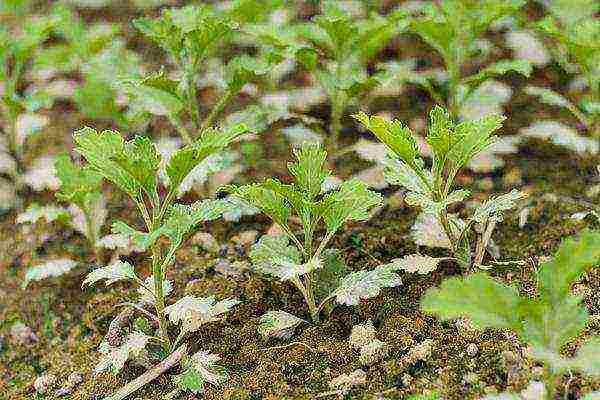
- Pour a couple of buckets of mullein or a bucket of chicken droppings into a large container, fill it with water, stir and let it infuse for three days - during this time the valuable highly concentrated fertilizer will be ready.
- Prepare a solution: add 10 liters of water to 1 liter of concentrated infusion.
- Apply 1 liter of solution under each plant only at the root and always on wet soil.
Further care for the chrysanthemum does not require much effort - regular watering, loosening, weeding, spraying from parasites.
Despite the fact that chrysanthemums tolerate the cold quite well, at the end of October, protect the flower bed from frost by placing a frame with plastic wrap on it - and you will admire the flowering of April cuttings for another month. You will remove the frame at the end of November, transplant the bushes into pots, and they will bloom on a warm, bright veranda even in January.
If you have recently been given a potted chrysanthemum, how to keep it until spring and planting in the garden, you can find out from the answer to the question "How to keep chrysanthemums until spring?" And the article The second life of a chrysanthemum from a bouquet is confirmation that the flower you like can be propagated by cuttings, even if you do not know the exact date of cutting.
Disease and pest control
Water-loving chrysanthemum, abundant watering, especially in the absence of rain, helps prevent the defeat of aphids and mites that cannot tolerate moisture.
Many harmful microorganisms and pathogens live in the soil.
diseases
, therefore, after each rain, treat the plants with drugs for diseases (for example, Quadris or Previkur). Protects from root rot
Fitosporin
, it can be added to the irrigation water with every top dressing.
Of all the enemies of chrysanthemums (leaf rollers, snails, aphids, ticks, etc.), caterpillars are the most dangerous. Only one of them can eat several buds per night. So keep your ears open, review your plantings regularly and take action on time. Good preparations for fighting insects are Aktara, Aktellik, Ratibor, Iskra, Fitoverm, etc.
Types and varieties of chrysanthemums
The genus of chrysanthemums has more than 150 species, but in our garden they grow mainly their hybrids. The classification of chrysanthemums is quite complex. There are main garden groups of hybrid chrysanthemums:
- Korean (small-flowered, inflorescence 2-9 cm),
- Indian (large-flowered, inflorescence 10-25 cm),
- Chinese and Japanese.
By the structure of the flower varieties are divided into the following groups:
- simple,
- semi-double,
- anemone,
- terry,
- flat,
- hemispherical,
- spherical,
- curly,
- pompom,
- radial.
By the structure of the petal distinguish tubular and reed. For growing in the garden, the most popular chrysanthemums are Korean, they are unpretentious, beautiful, bloom for a long time. Large-flowered species are usually grown for cutting and flower arrangements. Here are a few popular small-flowered varieties for your garden.
Chrysanthemum Korean Alyonushka
Bright pink non-double inflorescences 5-6 cm in diameter. Bush up to 50 cm tall. Blooms in September.
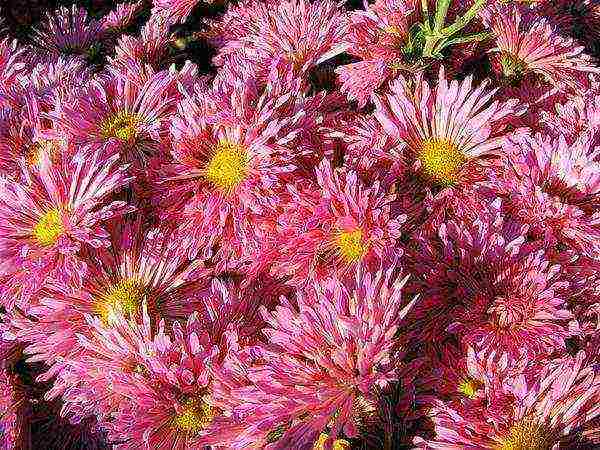
Chrysanthemum Korean dune
Small orange-yellow flowers, 5 cm in diameter. The height of the bush is 60 cm.
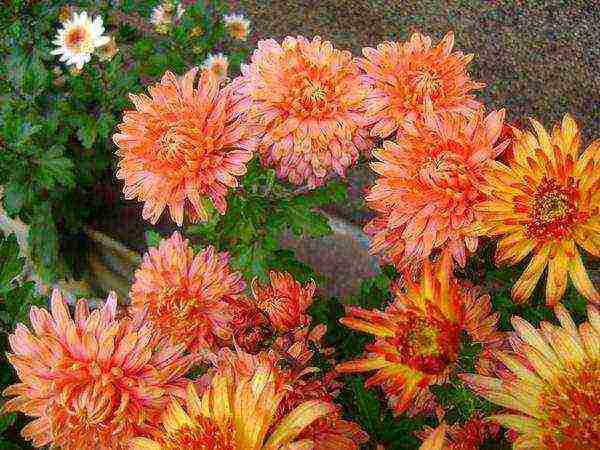
Chrysanthemum Korean Snowball
Terry inflorescences, small, 56 cm in diameter, white with slightly pink tips. Bush up to 60 cm high.
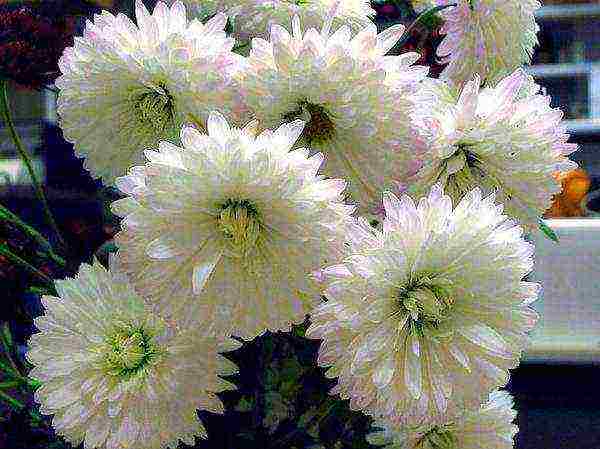
Korean chrysanthemum Mishal
Small-flowered terry chrysanthemum, inflorescences 4-4.5 cm, pompom, lush, bright yellow. Blooms from September. Bush up to 40 cm high.
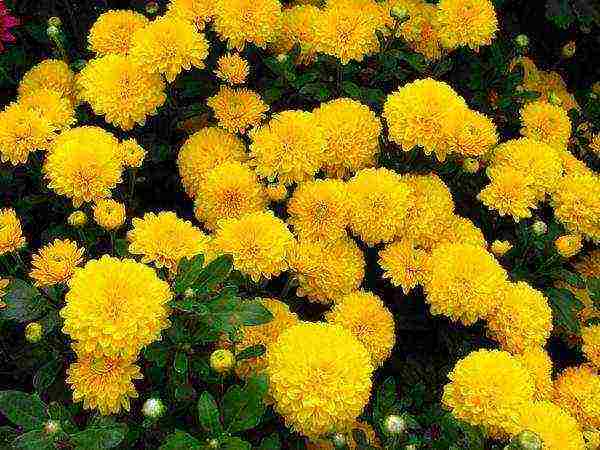
Chrysanthemum Korean Terracotta
Terry flowers, 5-6 cm in diameter, orange shades.The bush is 50-60 cm tall.
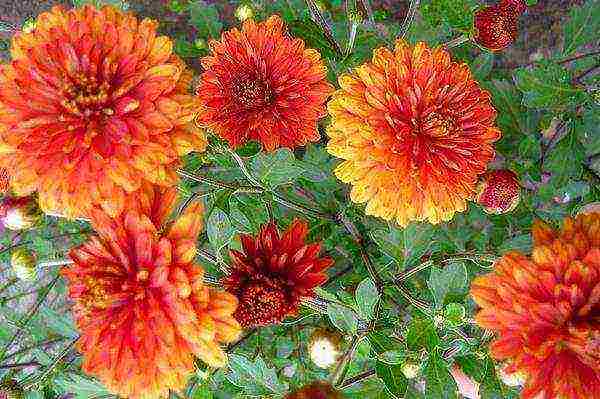
Chrysanthemum bush Saba
A very original color of chrysanthemum with a yellow-green core and reddish-lilac sharp petals with a white border. The diameter of the flower is 5 cm, the height of the bush is 60-70 cm.
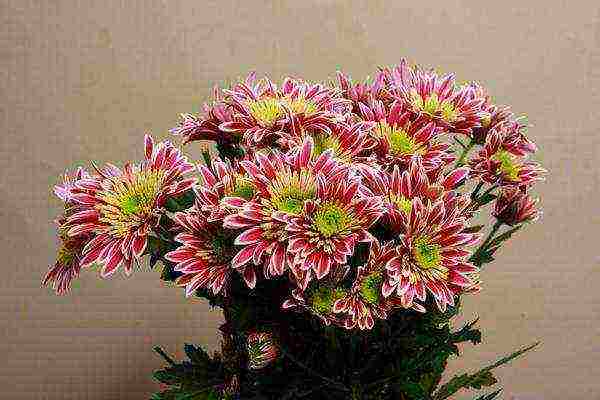
You can get acquainted with the recently fashionable variety series of large and small-flowered chrysanthemums by reading the publication
"Families" of chrysanthemums
.
Read more about chrysanthemums on our website:
- Chrysanthemum - a flower of longevity and transience of life
- The love story of the Japanese for chrysanthemums
- Chrysanthemum Legends
- Chinese chrysanthemums - the charm of antiquity
- Chrysanthemums of the Nikitsky Botanical Garden (very beautiful photos and descriptions of varieties)
- 8 queens of balls of chrysanthemums of Nikitsky botanical garden
- 17 personalized chrysanthemums of the autumn ball
- Old chrysanthemums in new optics
What chrysanthemums grow in your garden?
Korean chrysanthemums
Do you want to grow chrysanthemums in your garden but have no experience? Let's get together then
Let us analyze what and how to do. The easiest to grow are bush chrysanthemums, they are also called Korean. In most regions of our country, these flowers winter well in the open field. But for the northern regions it is better to choose early varieties, the late ones may simply not have time to bloom before frost.
Chrysanthemums reproduce in three ways:
- Seeds.
- Cuttings.
- By dividing the bush.
Which of these methods is better to choose for planting chrysanthemums in the garden?
Growing chrysanthemums from seeds
In order for the seedlings to grow and bloom in the first year, the seeds will have to be sown in January. If you do this later, then most likely you will see flowering only next fall.
There is no need to plant seeds in the ground, the sowing should be shallow. It is desirable to maintain the temperature at 17-18C. Young shoots appear in 10 - 15 days. Fortified seedlings should be laid out in cups. Plant in the garden in May - June.
I want to warn you that chrysanthemums grown from seeds do not always look like those flowers from which the seeds were collected. However, this is not always a bad thing. Sometimes plants are even more beautiful than expected. Nevertheless, it must be admitted that the seed method of reproduction of chrysanthemums is not the most popular among flower growers.
Planting chrysanthemums with cuttings
Rooted cuttings.
All chrysanthemums are easy to cut. If you don't have your own flowers yet and there is simply nothing to cut, then you can buy an already rooted cutting. It is preferable to plant such cuttings in the spring, then they will have time to root well and overwinter safely. But when buying a small and already blooming bush of chrysanthemums in the spring, one cannot be sure that by autumn it will not grow to 1m. and more.
You can see the real size of the purchased bush only in the fall. All autumn planting of chrysanthemums must be completed by the end of September. Planted later, they will not have time to really take root and may not overwinter.
Reproduction by dividing the bush
A feature of chrysanthemum agricultural technology is that at least once every three years, bushes growing in the garden must be dug up, divided into parts and planted. Otherwise, these plants begin to degenerate. Bushes become rare, flowers become smaller. If some of your friends are already growing bush chrysanthemums, then you can ask them for such a plot. Or buy it on the market. The division of the bush is always carried out in early spring.
Planting and caring for spray chrysanthemums
Where to plant chrysanthemums. These flowers should be planted in partial shade or in the sun. They grow poorly in deep shade.
The soil. Chrysanthemums can be grown on almost all soils, except clay soils. They grow very poorly in low, waterlogged places.
Landing. It is advisable to add 2-3 glasses of humus to each planting hole. Do not deeply deepen the roots when planting. Leave a distance of 30 - 40 cm between the bushes.
Top dressing. In order for a large and beautiful bush to grow from a small cutting, it needs good nutrition. To build up green mass, nitrogen is first of all needed. Therefore, 2 - 3 weeks after planting, feed your seedlings with any nitrogen fertilizer. Repeat feeding after 10 - 15 days. But with the appearance of buds, the plant will need phosphorus-potassium fertilizing. For this, you can use superphosphate and potassium sulfate.
Formation of bushes. To grow a nice and voluminous bush, you need to pinch it 2 times. When the height of the seedling is 10 - 12 cm, break off the top of its head. Side shoots will quickly begin to grow. After these shoots have grown 10 cm, pin them too. As a result, your plant will be bushy and not very tall.
Wintering in the open field. Shrub chrysanthemums are usually left to winter in the garden. The main enemy for them at this time is not cold, but dampness. Your pets will spend the winter safely if water does not collect around them. To do this, you just need to warm up the earth around the bushes, and insulate with leaves on top,
This chrysanthemum bush wintered in the basement
reeds, spruce branches.
Just do not use sawdust and film to cover flowers. If you want to cover your flower garden with something else, then let it be slate, boards, old tin. Any shelter must be breathable.
Chrysanthemum wintering in the basement. As a rule, large-flowered and spherical chrysanthemums are brought into the basement for the winter. If you are afraid of losing any sort of bush chrysanthemum, then it can also be overwintered in the basement or cellar.
To do this, with the onset of the first frost, cut the stems to the very ground. Dig up the bush and place it in any suitable container. Place it in a cellar with a temperature of 0-4C. Make sure that the ground does not dry out, but also does not get too wet. In April, divide the bush into several parts and plant them in the garden.
Save article to:
Dear visitors of the "Dacha Plot", tireless gardeners, gardeners and flower growers. We offer you to pass the aptitude test and find out whether you can trust the shovel and let you into the garden with it.
Test - "What kind of summer resident I am"
Share this article with your friends:


